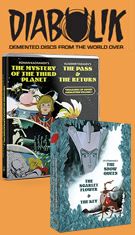
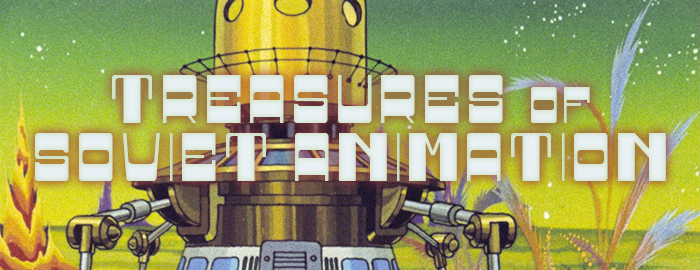


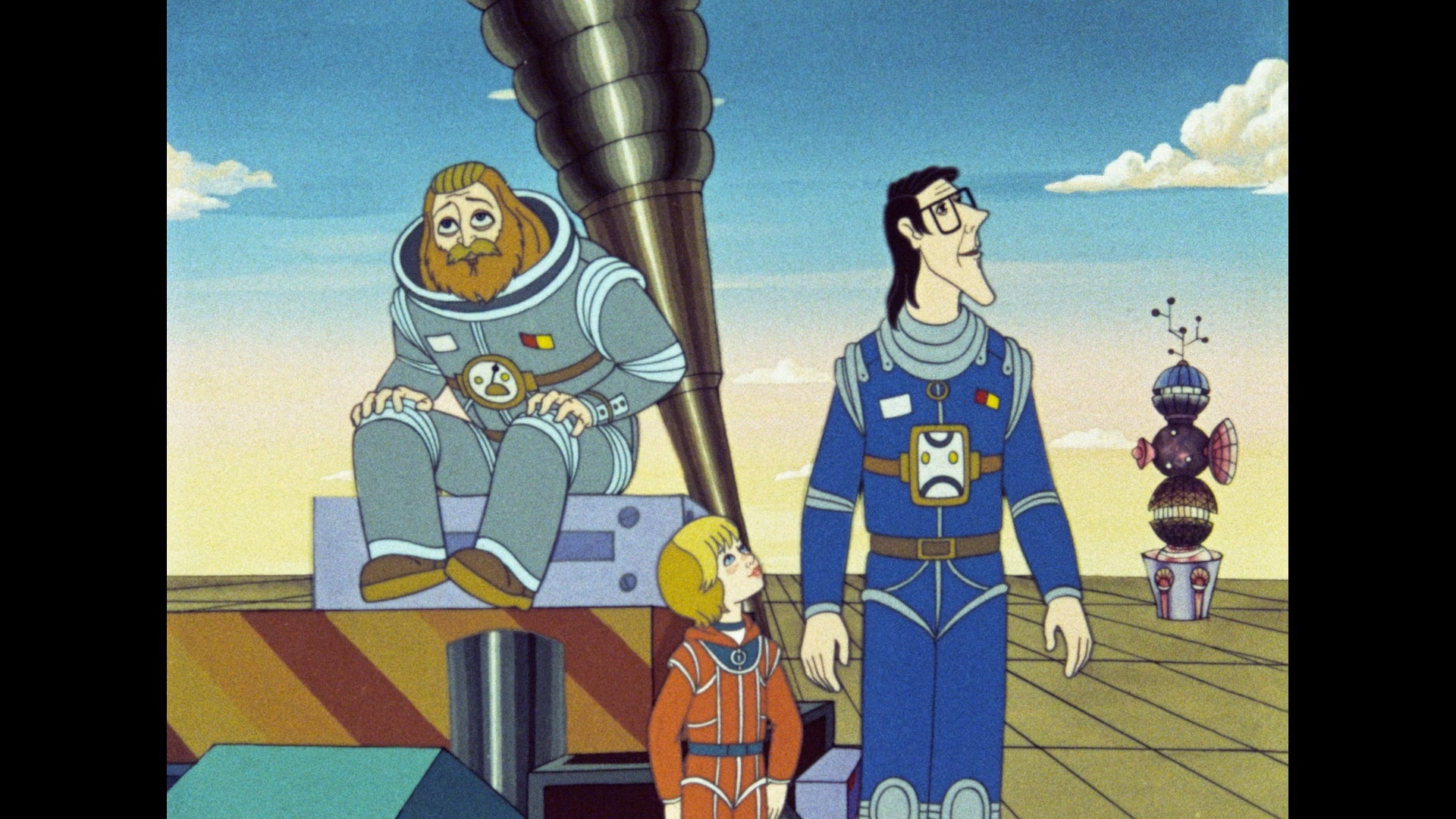 explorations of European animation in all its psychedelic varieties, Deaf Crocodile turns its ear to the Soviet Union from
explorations of European animation in all its psychedelic varieties, Deaf Crocodile turns its ear to the Soviet Union from 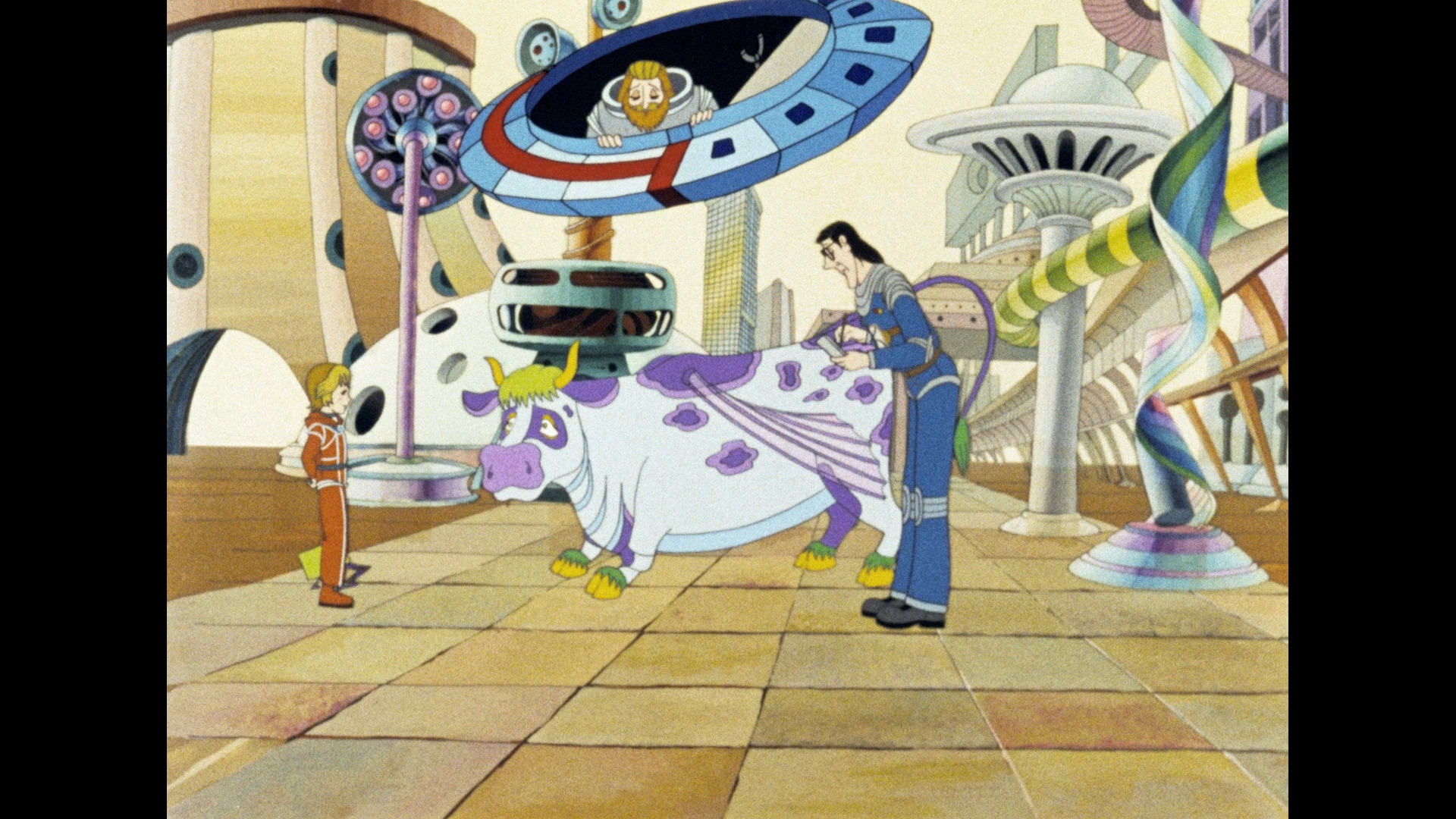 the early '50s to the early '80s with two Blu-ray releases, Treasures of Soviet Animation 1 and 2. Each one contains three films of wildly varying lengths with a sci-fi or fantasy bent, though they play like absolutely nothing else out there.
the early '50s to the early '80s with two Blu-ray releases, Treasures of Soviet Animation 1 and 2. Each one contains three films of wildly varying lengths with a sci-fi or fantasy bent, though they play like absolutely nothing else out there.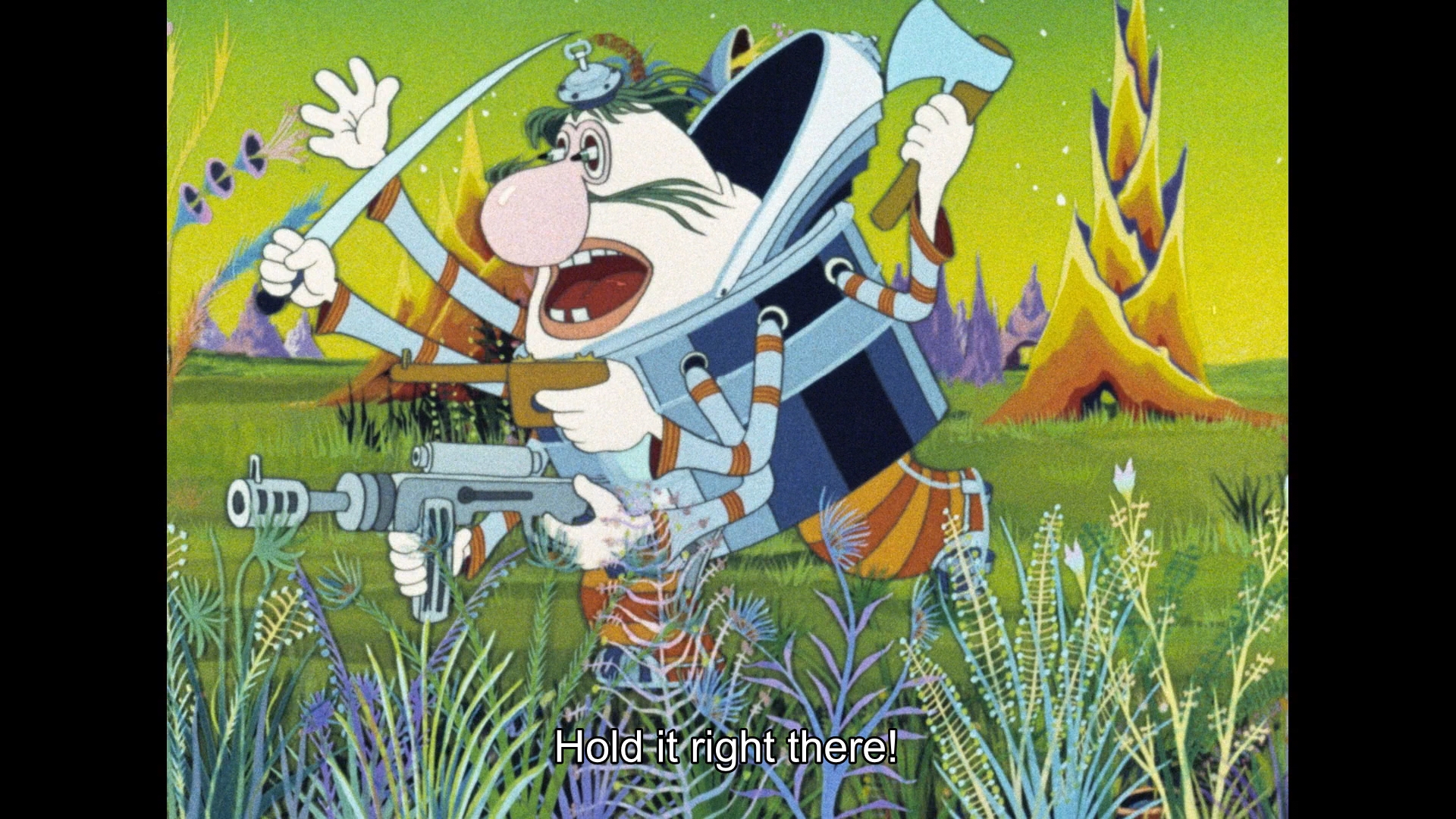 alien archaeologist Gromozeka, who plays a key role in their latest adventure. With its vibrant colors and expressive,
alien archaeologist Gromozeka, who plays a key role in their latest adventure. With its vibrant colors and expressive, 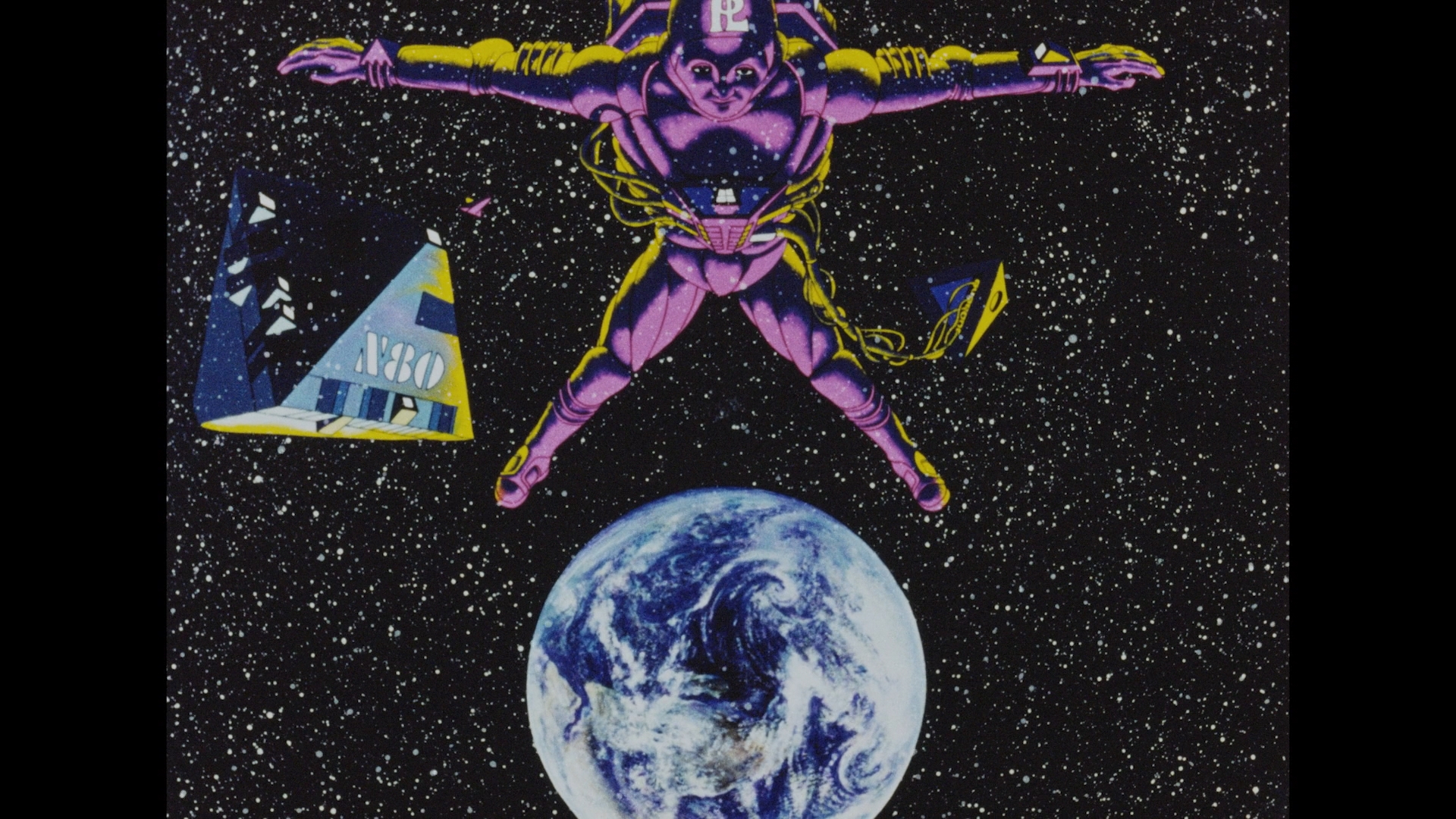 detailed animation, this is a great way to dive into the set. The swift pacing, oddball characters, and funky pseudo-classical score make for a fun place to swirl around in for less than an hour, and it's no wonder a cult following built up around it. The transfer here looks beautiful (as with the other titles in the sets) with excellent detail and fine film grain. The Russian 2.0 mono track sounds pristine and comes with optional English or English SDH subtitles. A new commentary by Adam Rackoff, James Hancock and Martin Kessler is great accompaniment as well as they talk about the various pop culture spin-offs of this film (action figures!), the complex nature of the soundtrack, the possible influence of Yellow Submarine, the two different English dubs that were created (not on this disc but easily accessible if you're curious), and the animation techniques that give the film extra charm like having the characters always moving in some way. The video essay "Roman Kachanov and The Mystery of the Third Planet" by Evan Chester ((21m11s)) covers the director's life after his military service as he was trained in animation and worked up to becoming a beloved figure for young and old alike, with this film being one of his pivotal works.
detailed animation, this is a great way to dive into the set. The swift pacing, oddball characters, and funky pseudo-classical score make for a fun place to swirl around in for less than an hour, and it's no wonder a cult following built up around it. The transfer here looks beautiful (as with the other titles in the sets) with excellent detail and fine film grain. The Russian 2.0 mono track sounds pristine and comes with optional English or English SDH subtitles. A new commentary by Adam Rackoff, James Hancock and Martin Kessler is great accompaniment as well as they talk about the various pop culture spin-offs of this film (action figures!), the complex nature of the soundtrack, the possible influence of Yellow Submarine, the two different English dubs that were created (not on this disc but easily accessible if you're curious), and the animation techniques that give the film extra charm like having the characters always moving in some way. The video essay "Roman Kachanov and The Mystery of the Third Planet" by Evan Chester ((21m11s)) covers the director's life after his military service as he was trained in animation and worked up to becoming a beloved figure for young and old alike, with this film being one of his pivotal works. 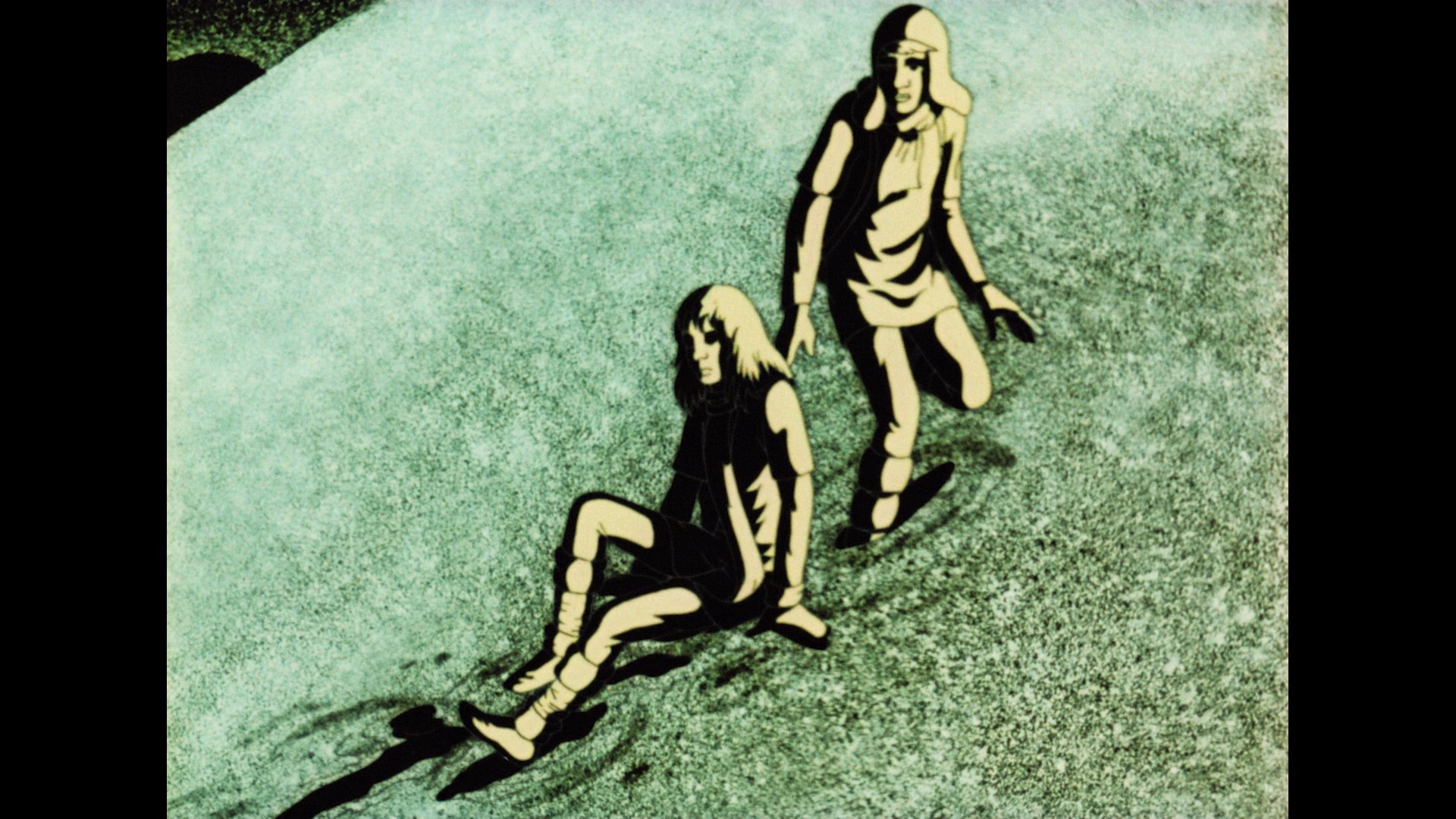 Return from 1980. Here a cosmonaut in hypersleep won't wake up as his descent to Earth approaches, with ground control and the ship itself trying to rouse him from his vivid
Return from 1980. Here a cosmonaut in hypersleep won't wake up as his descent to Earth approaches, with ground control and the ship itself trying to rouse him from his vivid 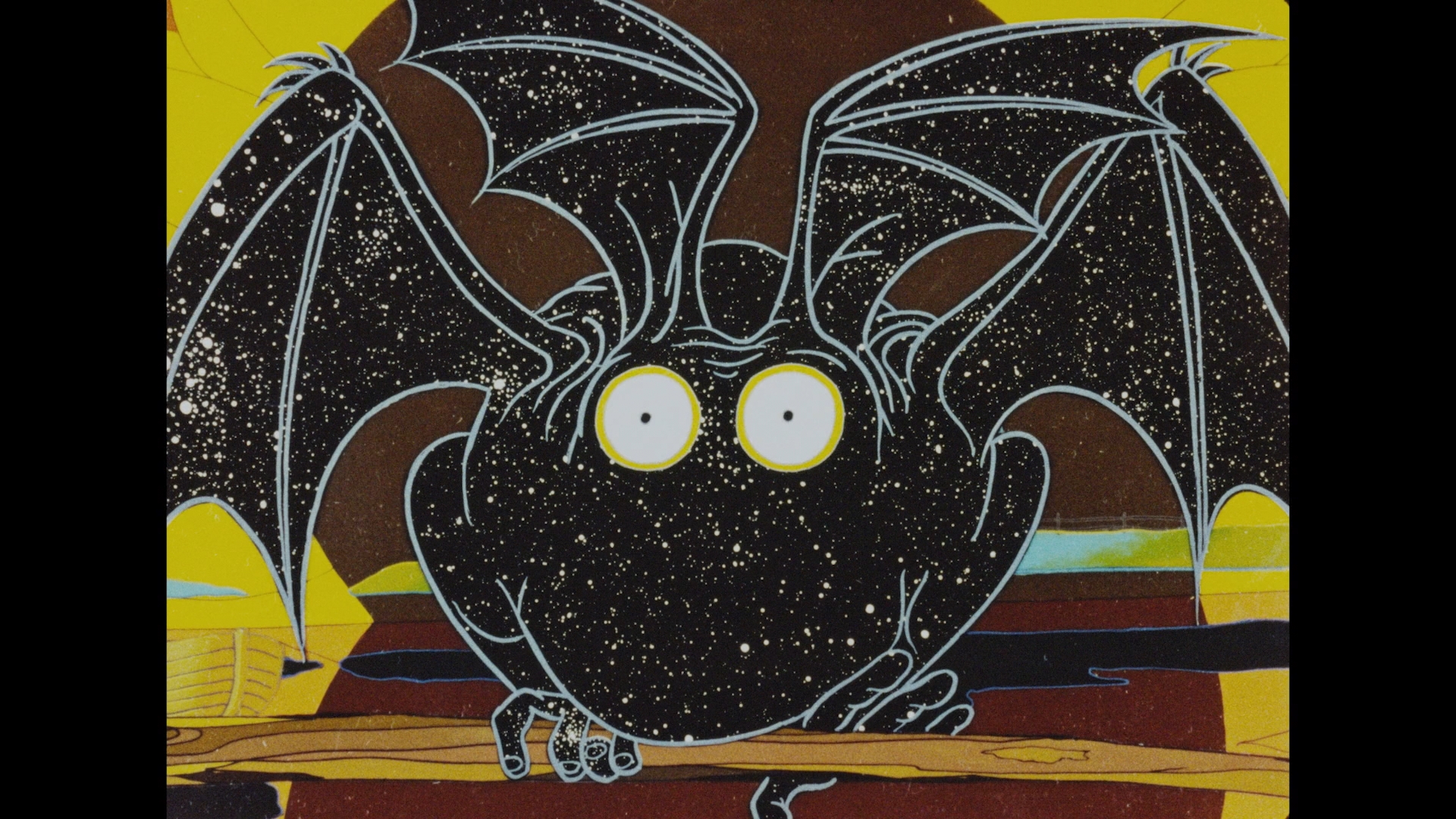 daydreams or memories focused around childhood and floating in space. Eventually a novel yet simple solution seems to present itself. Very much in keeping with the tone of David Bowie's Major Tom cycle, this is a beautiful and hypnotic vignette. Running much longer at half an hour is Tarasov's The Pass from 1988, written by Kir Bulychov from a portion of his novel The Settlement. Essentially it's a snapshot in the existence of survivors of a spaceship crash who are now stranded on a harsh planet inhabited by alien lifeforms. The young of them, Oleg, was a baby when they arrived, and now they live far from the crash site. When a trip back to the ship is necessary, Oleg and three others make the trek by foot and reconnect with their earthly existence while finding a renewed sense of purpose. The animation here is moody and beautiful with wild shades of yellow and red, including a spellbinding storytelling sequence around candlelight, and the environment is give a great deal of attention and detail that would put many feature-length films to shame. Specs are the same here, and the same trio return for an audio commentary covering comparisons to the source novel (which has more of a split narrative), the beautiful nuances of the animation and use of color, the unorthodox score choices, and ties to the rest of his work. Chester is also back with another video essay, "Vladimir Tarasov" (17m20s), featuring extensive coverage about his many short films, his amusing appropriation of familiar cartoon characters, the adoption of jazz and familiar soundtrack music in his films, and Bulyachov's issues with the end
daydreams or memories focused around childhood and floating in space. Eventually a novel yet simple solution seems to present itself. Very much in keeping with the tone of David Bowie's Major Tom cycle, this is a beautiful and hypnotic vignette. Running much longer at half an hour is Tarasov's The Pass from 1988, written by Kir Bulychov from a portion of his novel The Settlement. Essentially it's a snapshot in the existence of survivors of a spaceship crash who are now stranded on a harsh planet inhabited by alien lifeforms. The young of them, Oleg, was a baby when they arrived, and now they live far from the crash site. When a trip back to the ship is necessary, Oleg and three others make the trek by foot and reconnect with their earthly existence while finding a renewed sense of purpose. The animation here is moody and beautiful with wild shades of yellow and red, including a spellbinding storytelling sequence around candlelight, and the environment is give a great deal of attention and detail that would put many feature-length films to shame. Specs are the same here, and the same trio return for an audio commentary covering comparisons to the source novel (which has more of a split narrative), the beautiful nuances of the animation and use of color, the unorthodox score choices, and ties to the rest of his work. Chester is also back with another video essay, "Vladimir Tarasov" (17m20s), featuring extensive coverage about his many short films, his amusing appropriation of familiar cartoon characters, the adoption of jazz and familiar soundtrack music in his films, and Bulyachov's issues with the end 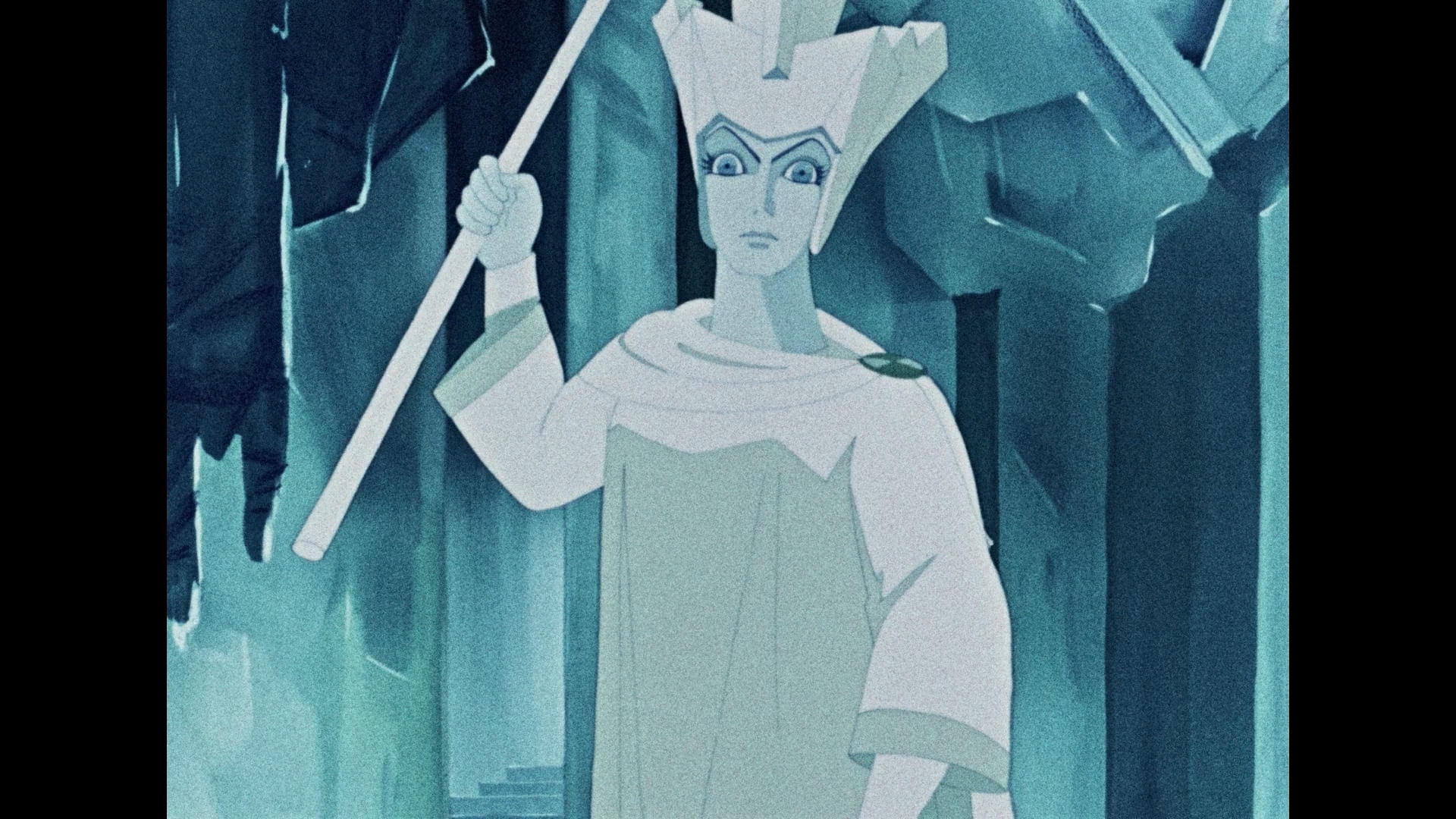 result of The Pass.
result of The Pass. 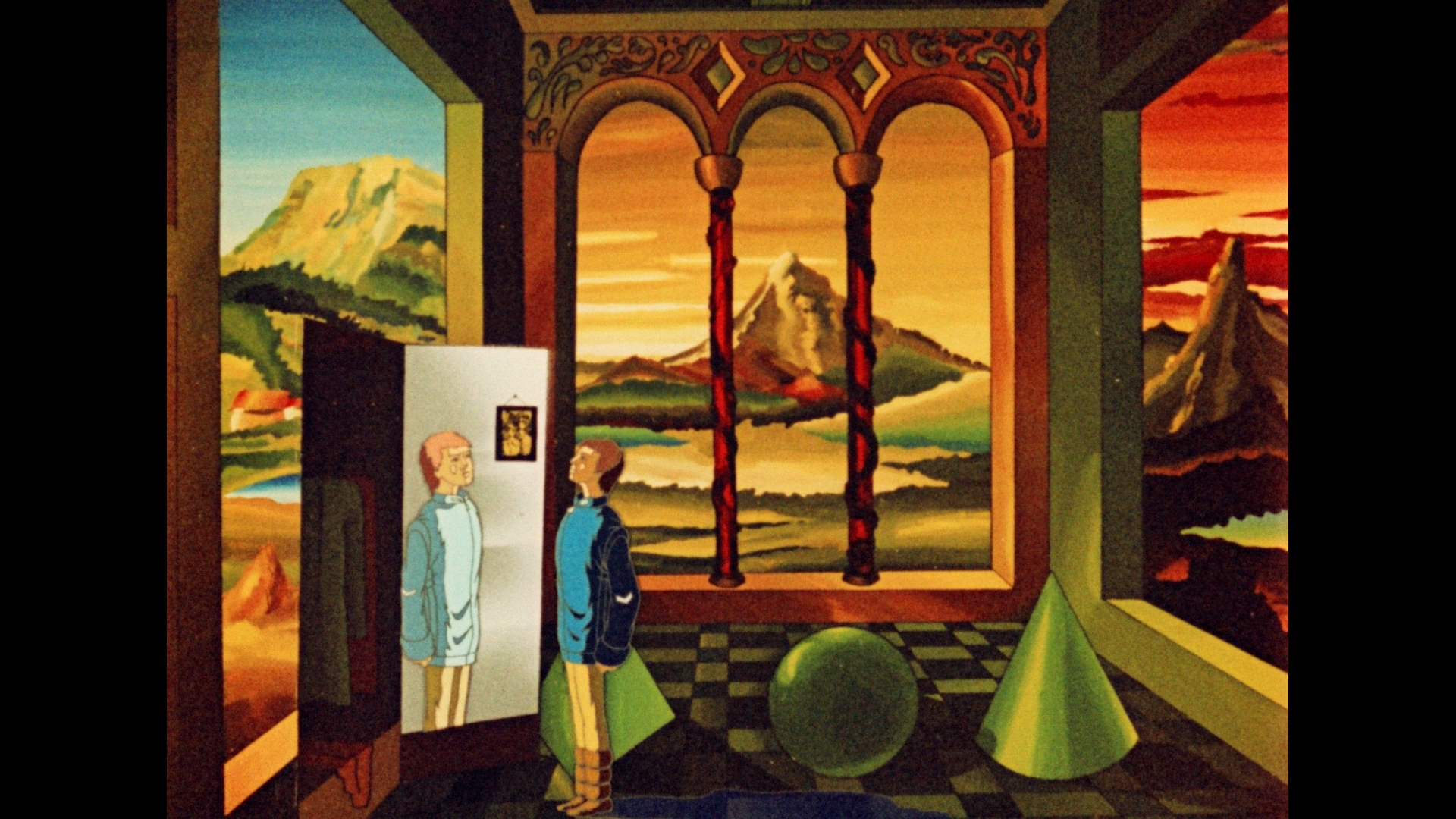 As usual this comes in a standard edition or a limited one featuring a slipcase designed by Haleigh Buck and a booklet with essays by Jennifer Lynde Barker and Walter Chaw.
As usual this comes in a standard edition or a limited one featuring a slipcase designed by Haleigh Buck and a booklet with essays by Jennifer Lynde Barker and Walter Chaw.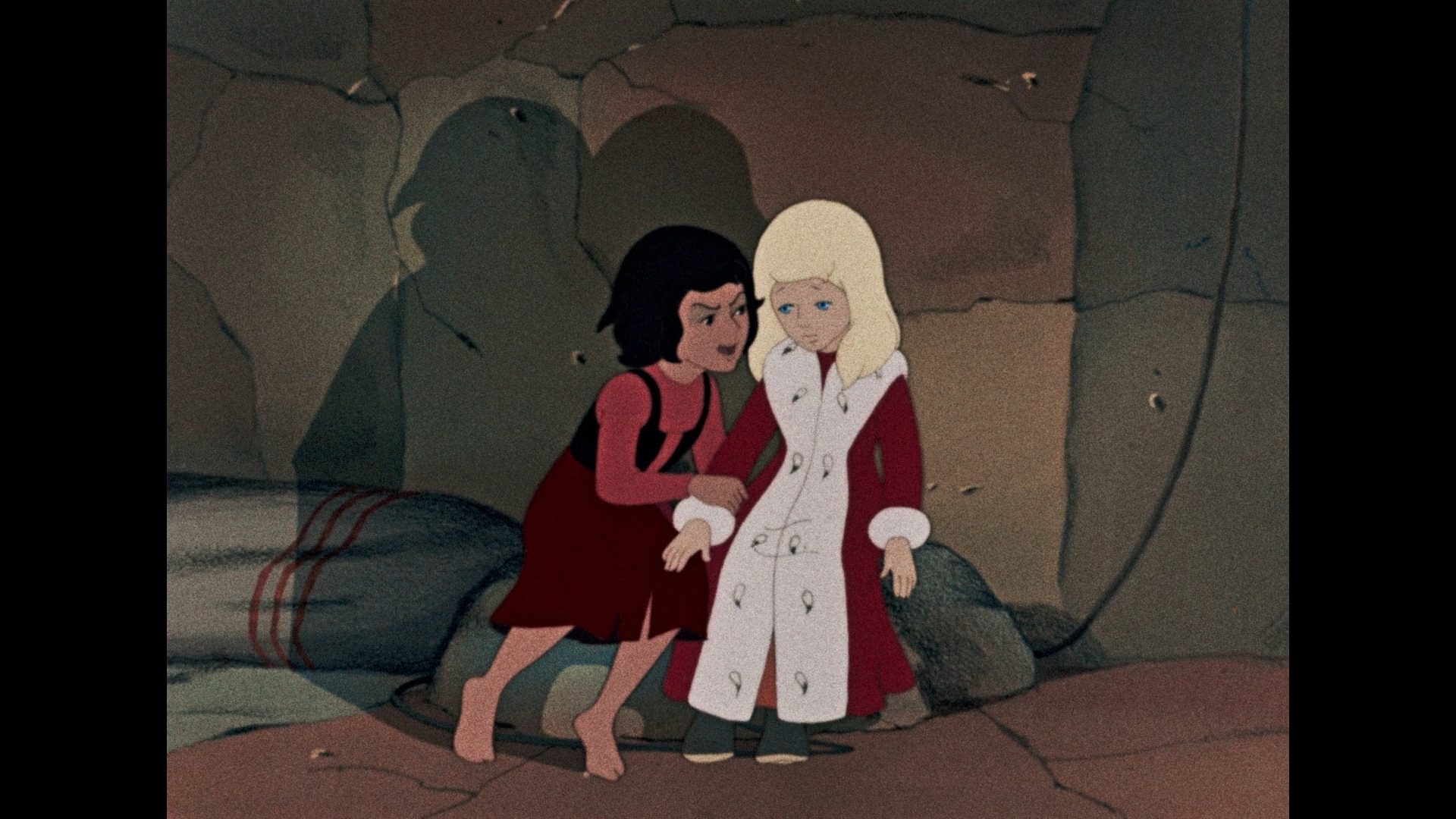 new mystical
new mystical 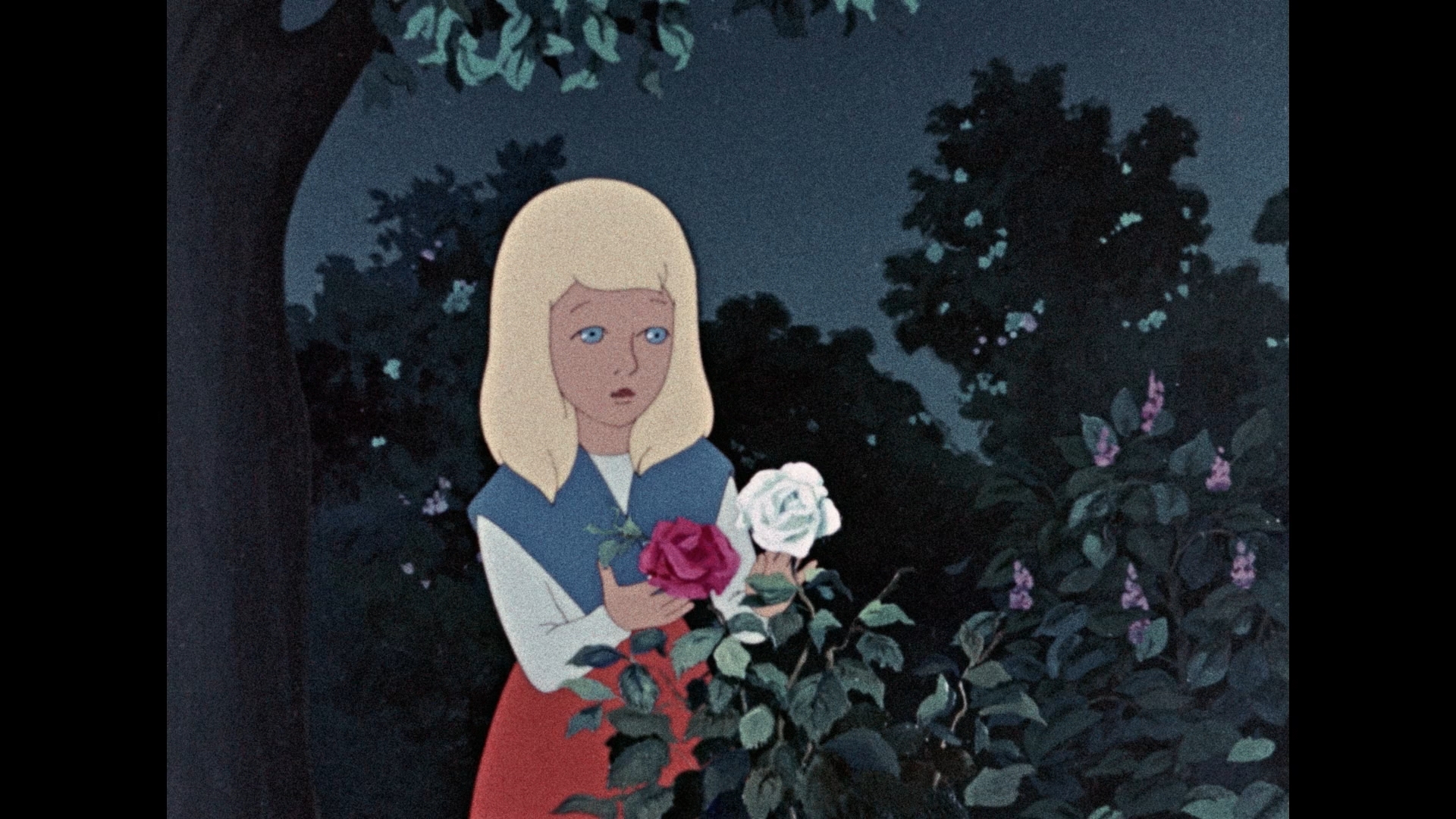 friends including a raven and a reindeer to get him back. There's definitely a touch of Disney here (especially Snow White), but the inventive animation has a personality all its own with particularly vivid use of snow flurries and the striking Queen herself standing out in particular.
friends including a raven and a reindeer to get him back. There's definitely a touch of Disney here (especially Snow White), but the inventive animation has a personality all its own with particularly vivid use of snow flurries and the striking Queen herself standing out in particular. 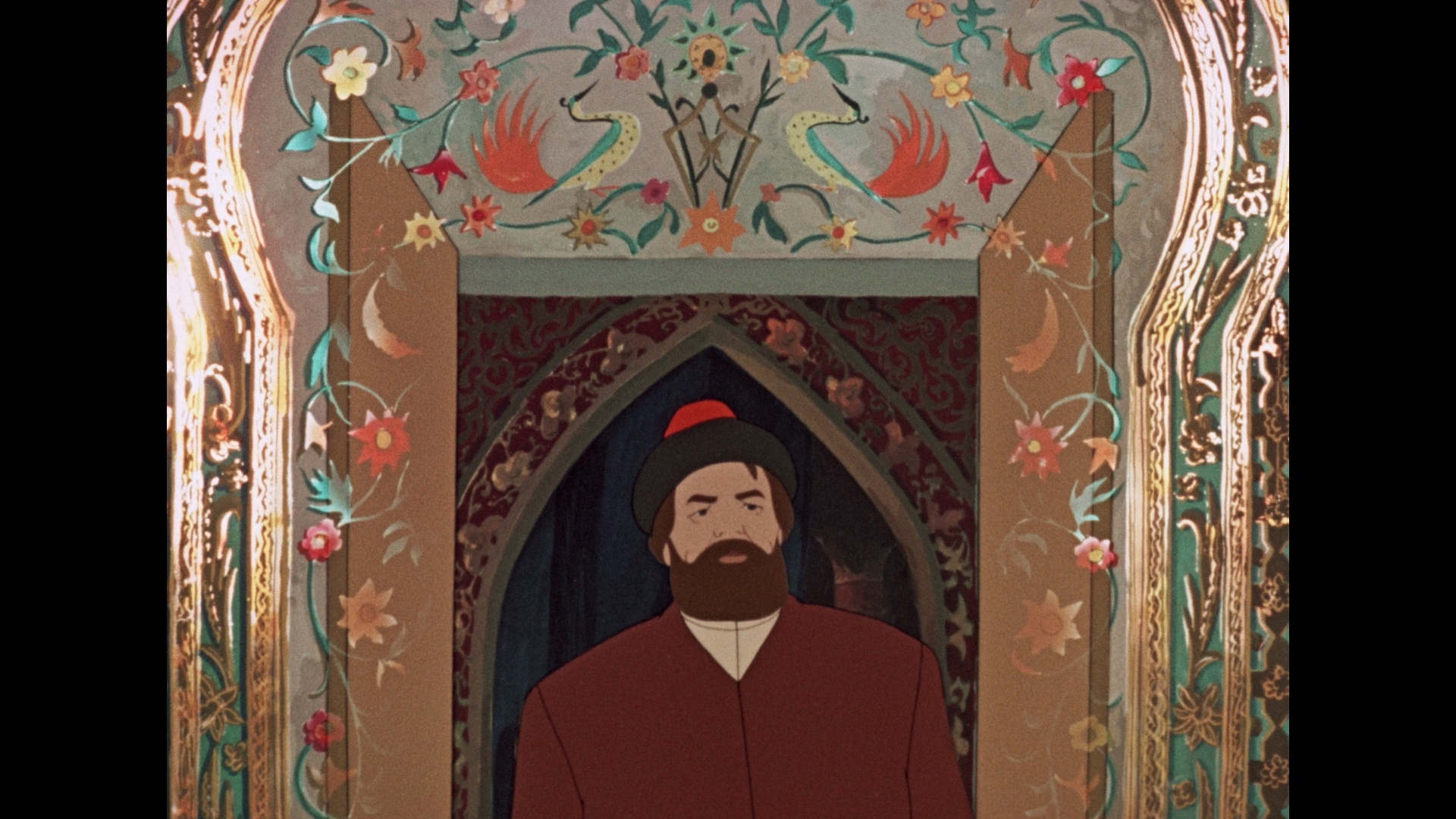 pretty much everything you could want to know about the film and its development by the director and his
pretty much everything you could want to know about the film and its development by the director and his 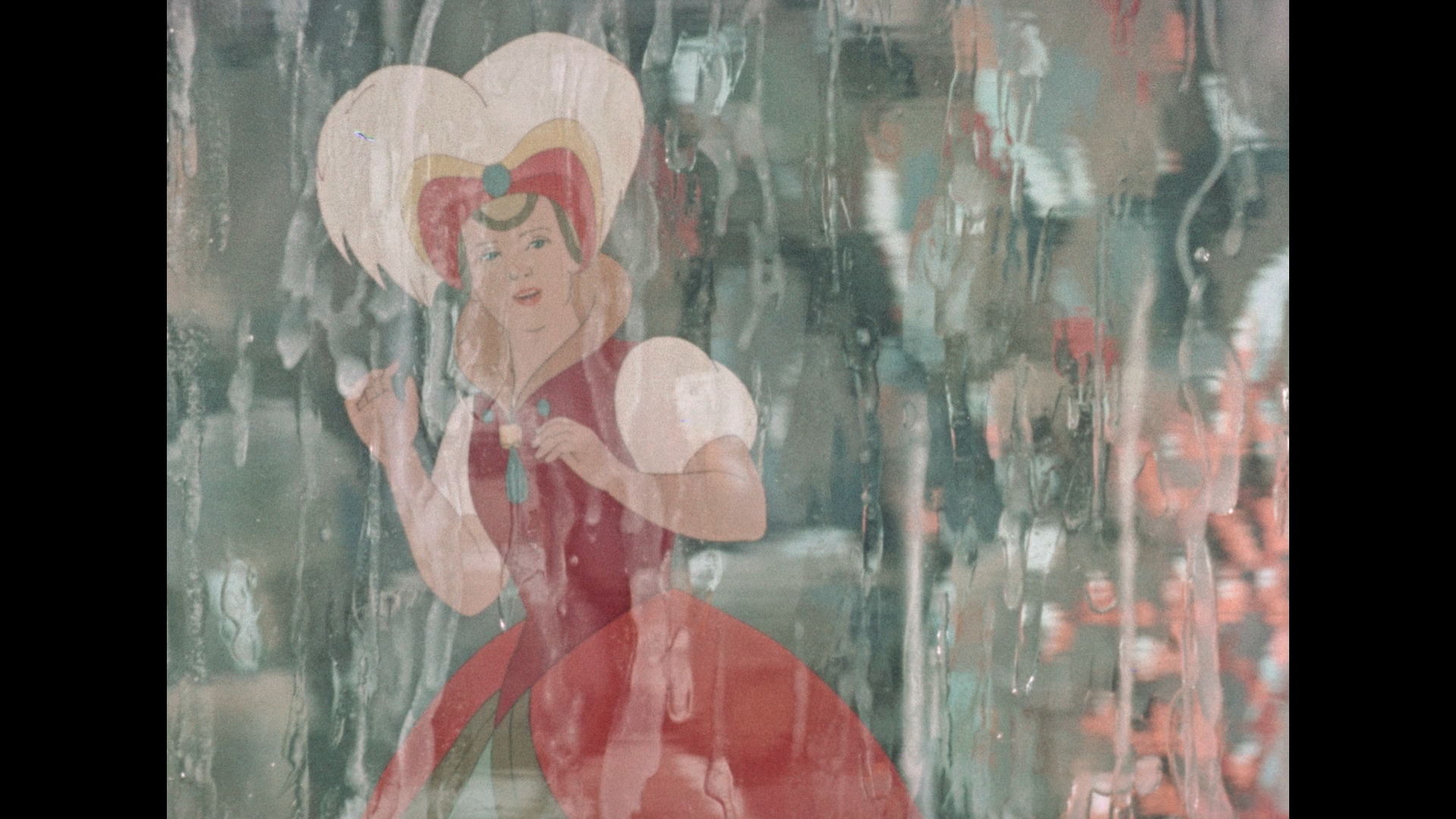 team, including the color process involved, the influences on Soviet animation after World War II, and international artists who also had an impact.
team, including the color process involved, the influences on Soviet animation after World War II, and international artists who also had an impact.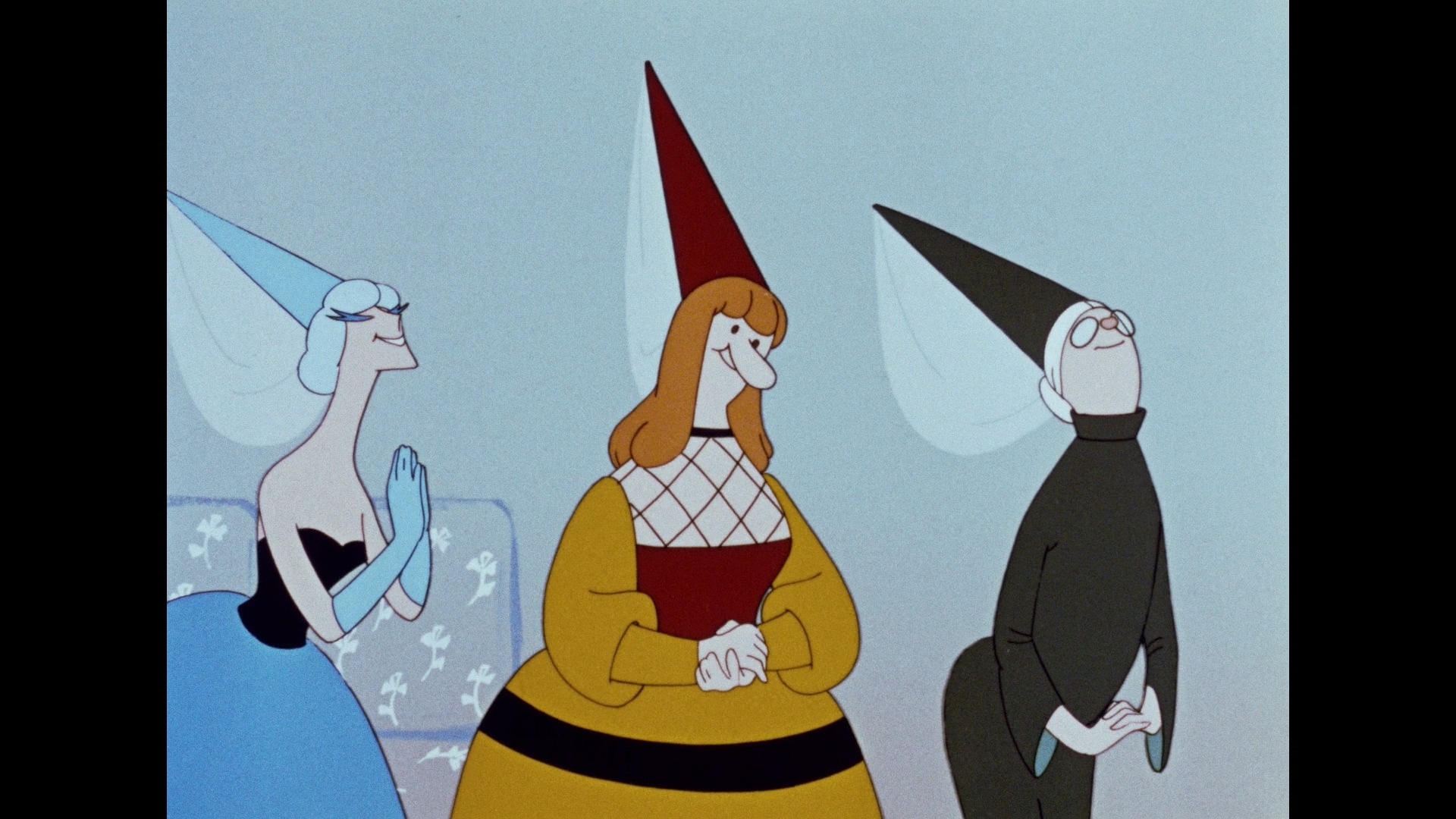 1961's The Key is a very oddball hour-long parable with a radically different, stripped-down caricature style as it presents three hard-partying
1961's The Key is a very oddball hour-long parable with a radically different, stripped-down caricature style as it presents three hard-partying 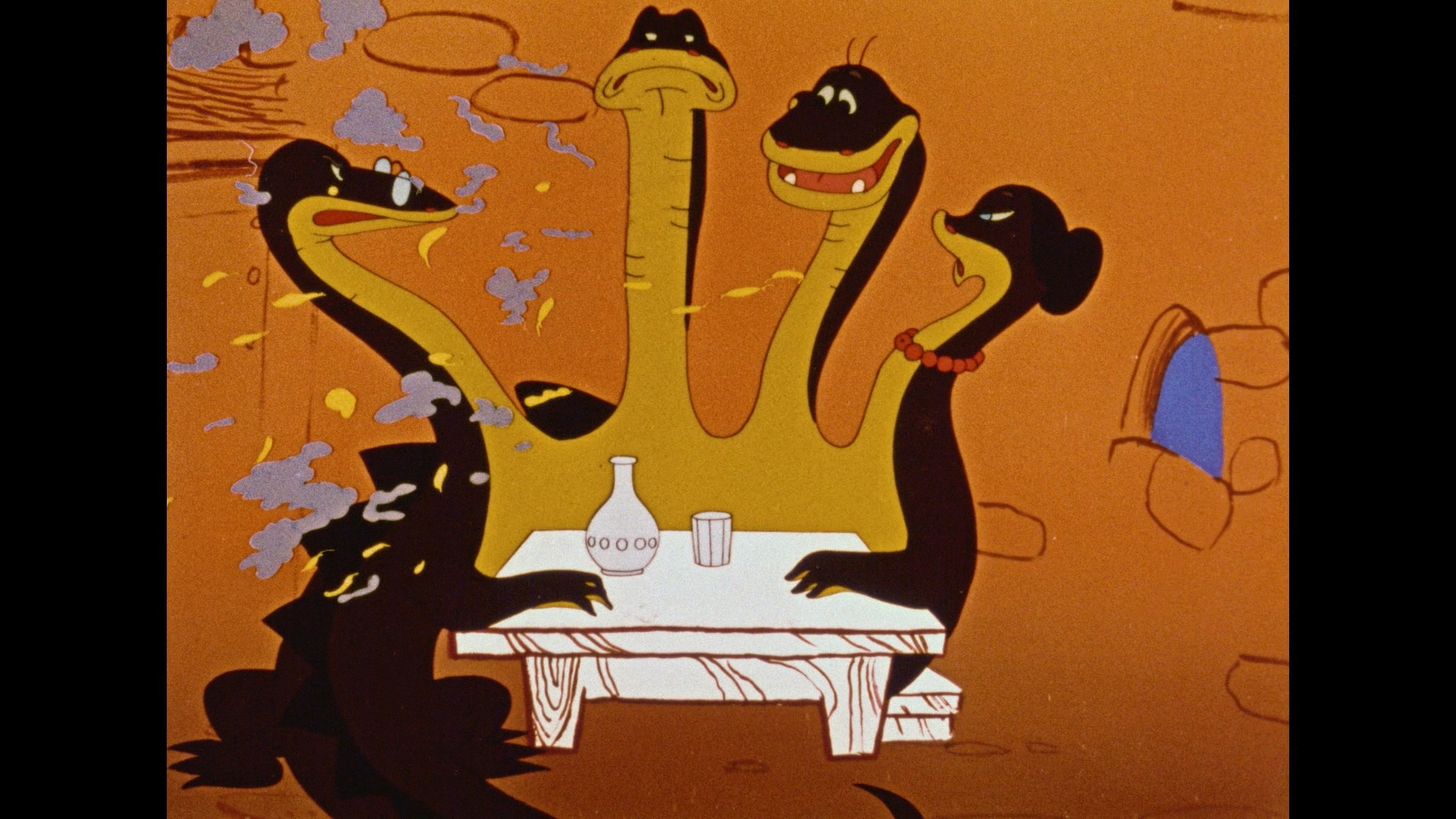 fairies who bless a newborn boy with a magic ball of string and a promise of a fulfilling life. With the child growing at an accelerated rate, his grandfather protests the easy path he's been given ("Those who do not work, do not eat!") and embarks on a quest to the Land of Happiness where he and the boy learn the cost of laziness and indulgence. Also, there's a four-headed dragon and a lot of robots and sentient tools. Propaganda in fairy tales is hardly unique, and this one pushes it in a crazy direction with the increasingly exasperated grandpa navigating fanciful obstacles galore to get to the lesson of the story -- all with a very stylized look common to what you'd see in the 1960s. Again the restoration of the Russian-language film is immaculate, with Giesen delivering another commentary laying out the climate of the time that produced this, Atamanov's status as a premiere name in state entertainment by this point, the state of Soyuzmultfilm by this point, and the market for medium-length projects like this. On the video extras front, Chester's visual essay "Written with Ice Crystals: Master Soviet Animator Lev Atamanov and The Snow Queen" (19m5s) surveys the maestro's career, his transitional status in Soviet animation history, the basic principles guiding his work, and the key films along the way. In "Innocence & Cynicism: The Snow Queen and Hayao Miyazaki" (10m48s), John Adkins of Animation Obsessive hones in on the fairy tale film's importance to the Japanese animation legend, the impact of its release in Japan, the resonance of Gerda's character, and the lingering effects its screening in the mid-'60s had on the younger director's work throughout his career. This one is also available as a standard version or a limited edition, the latter featuring a slipcase with art by Haleigh Buck and a booklet with essays by Giesen (who delivers a very thorough, extensive breakdown of Atamanov's career and early Soviet animation) and Walter Chaw analyzing the themes and fairy tale elements of all three films.
fairies who bless a newborn boy with a magic ball of string and a promise of a fulfilling life. With the child growing at an accelerated rate, his grandfather protests the easy path he's been given ("Those who do not work, do not eat!") and embarks on a quest to the Land of Happiness where he and the boy learn the cost of laziness and indulgence. Also, there's a four-headed dragon and a lot of robots and sentient tools. Propaganda in fairy tales is hardly unique, and this one pushes it in a crazy direction with the increasingly exasperated grandpa navigating fanciful obstacles galore to get to the lesson of the story -- all with a very stylized look common to what you'd see in the 1960s. Again the restoration of the Russian-language film is immaculate, with Giesen delivering another commentary laying out the climate of the time that produced this, Atamanov's status as a premiere name in state entertainment by this point, the state of Soyuzmultfilm by this point, and the market for medium-length projects like this. On the video extras front, Chester's visual essay "Written with Ice Crystals: Master Soviet Animator Lev Atamanov and The Snow Queen" (19m5s) surveys the maestro's career, his transitional status in Soviet animation history, the basic principles guiding his work, and the key films along the way. In "Innocence & Cynicism: The Snow Queen and Hayao Miyazaki" (10m48s), John Adkins of Animation Obsessive hones in on the fairy tale film's importance to the Japanese animation legend, the impact of its release in Japan, the resonance of Gerda's character, and the lingering effects its screening in the mid-'60s had on the younger director's work throughout his career. This one is also available as a standard version or a limited edition, the latter featuring a slipcase with art by Haleigh Buck and a booklet with essays by Giesen (who delivers a very thorough, extensive breakdown of Atamanov's career and early Soviet animation) and Walter Chaw analyzing the themes and fairy tale elements of all three films. ![]()